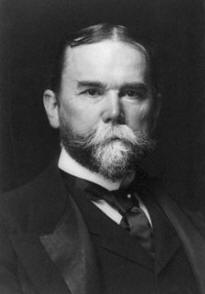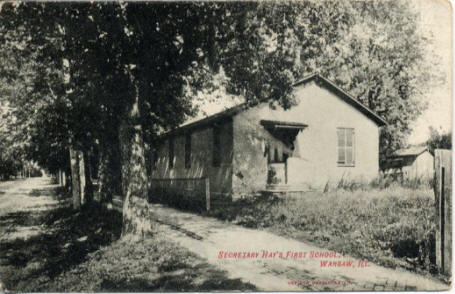|
 |
|
ONE HIT WONDER:
WARSAW,
ILLINOIS |
|
“One Hit Wonder” is
a term sometimes used to describe a singer generally known for producing
only one hit recording before fading into obscurity. Examples include
Rick Dees’ “Disco Duck” and C.W. McCall’s “Convoy.”
But in my opinion, the term can also be used to describe those cities
that have only one (or at the most, two) shot glasses attributable to
them. In my list of these cities, Warsaw, Illinois, is the number one
“One Hit Wonder.” Compliments of John H. Giller and Martin Popel,
Warsaw’s sole shot glass claim to fame is shown here. The label reads:
Try
HANCOCK COUNTY
FAMOUS
FRUIT BRANDIES
Popel & Giller
Distillers
WARSAW, ILL.
The glass is
two-and-one-half inches tall, one-and-seven-eighths inches wide at the
top, and one-and-nine-sixteenths inches wide at the base.
Warsaw, Illinois, is a central Illinois town of about 1800 people,
situated on the east bank of the Mississippi River in Hancock County.
Although the town was founded in 1834, its pre-history dates back to
1814, when Major (and future United States president) Zachary Taylor
founded a federal military outpost at the site of the future town.
Called Fort Johnson, it was occupied only a month before it burned down,
but another military camp, Fort Edwards, was built there in 1816. Fort
Edwards became an important fur trading post and one of the earliest
settlements in Western Illinois. It was eventually abandoned in 1824.
John M. Hay, an
American statesman, was raised in Warsaw. He was Abraham Lincoln’s
secretary, and he also served as U.S. Secretary of State from 1898 to
1905 under presidents William McKinley and Theodore Roosevelt. (My
college friend Steve Sheffler also hails from Warsaw, but as far as I
know, he has no political aspirations.)
John Hay, whose picture is shown at left above, must be Warsaw’s
favorite son (sorry, Steve). The1910 postcard shown alongside (above
right) features Hay’s first school.
| Warsaw can boast of
three architectural wonders. The first is the Fort Edwards
State Memorial, a 45-foot-tall obelisk that was erected in
1914 (right). The second
is an 18-foot-tall replica of the Statue of Liberty (below).
Frank Connor, a successful Chicago businessman, purchased
the statue and had it placed in the town’s Ralston Park. It
was dedicated to the Boy Scouts of America in 1950.
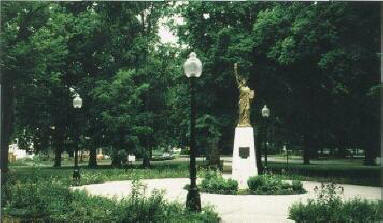 |
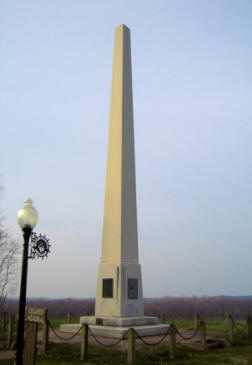 |
This Popel & Giller
glass clearly indicates that the two men were distillers. But the
spirits business was not their only occupation. Warsaw’s third
architectural wonder is the Popel and Giller Brewery building. Here is
both the building and its timeline.
TIMELINE:
1860 – Rudolph Giller establishes his brewery at 920 N. 6th
Street in Warsaw.
1861 – The brewery is sold to Martin Popel; it is renamed the
Martin Popel Brewery.
1880 – John H. Giller becomes a partner; the brewery is renamed:
Popel & Giller, Warsaw Brewery.
1906 – The name is shortened to Popel-Giller Co.
1920 – Prohibition shuts down the brewery
1935 - The brewery opens up and is renamed the Burgemeister
Brewing Co.
1936 – The brewery is renamed the Warsaw Brewing Co.
1938 – The brewery is renamed the Warsaw Brewing Corp.
1970-72 – The brewery also does business as the Crown Brothers
Brewing Co.
1972 – The brewery closes again.
2006 – The building opens up as the Warsaw Brewery; it is now an
upscale bar, restaurant, and banquet hall.
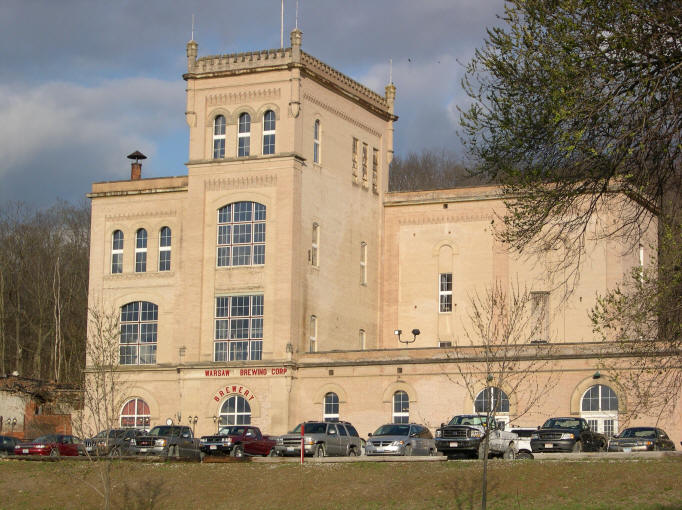
| This massive building is not the only
remnant of the brewery’s former glory. For example, this
Bohemian Beer label (below) preserves the
Popel-Giller name.
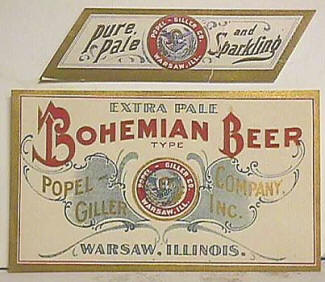
|

This “Sammie” label is an example of an early Prohibition
label. By now, “beer” is both literally and figuratively a
four-letter word; its use is forbidden. The alcohol content
is less than one-half of one percent. The beverage is no
longer brewed; instead, it is “manufactured.” Finally, note
the World War I theme. |
| When the brewery opened
up in 1935 as the Burgemeister Brewing Co., it established
the Burgemeister and Old Tavern brands. Here is a bottle
opener of the former and a label of the latter. |
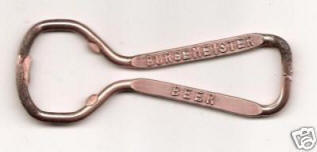 |
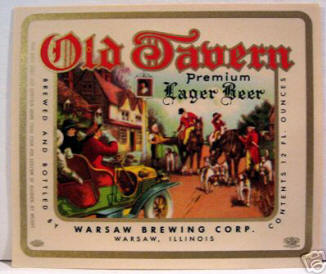 |
| Finally, here are two
old Popel and Giller beer bottles.
But enough about beer. What about the
shot glass? I could find no evidence that Popel and Giller
ever distilled whiskey. Perhaps these “fruit brandies” they
advertised were a sideline to their brewery business.
The name on the glass is “Popel & Giller.” The timeline
suggests that this glass dates from 1880 to 1906.
This glass, though modest in appearance, appears to be quite
rare. Since Robin began keeping records, it has
appeared
only once on eBay, in August of 2004, where it garnered
a very respectable, if not remarkable, $75.89. At the time,
I watched the bidding escalate back and forth between two
individuals who clearly had never heard of sniping, but
instead were both determined to win the glass at all costs.
|
  |
I next saw this
glass at the
St. Louis bottle show last year. (Who knows; it might have been the
same glass that I saw on eBay in 2004.) I probably would have purchased
it at the show, but lakerdude33 saw it first and beat me to it.
Months later, when he was in a feeding frenzy over labels-under-glass, I
bought it from him.
Popel and Giller were distillers, but to date it appears that no one has
uncovered a true pre-prohibition whiskey (not fruit brandy) shot glass
that bears their name. Who knows, perhaps some day a Popel and Giller
“Warsaw Whiskey” shot glass will appear at some farm auction in Central
Illinois.
If it does, it
might well be the find of the year. |

